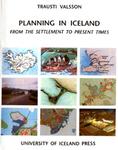open spaces urban africa ifau2018 housing sprawl inu study day design scali ferroviari landscapes populations strategic planning urban practices social housing central places giornata di studi inu urbanism industrial sites surveys & analyses call for articles renaissance città storica architecture city-regions city neighborhood
Planning In Iceland - Review
by Romina Peritore
In his book, Trausti Valsson analyses the development of settlements and urban areas, in Iceland, from 874 to the present-day. It is a comprehensive study of the evolution of human habitat in relation to the forces of nature. Iceland is a country with a low population density, characterized by considerable variations in topography, a wide variety of natural resources, which is undergoing economic and social transformations. As a result, the author analyses the history of planning from its beginnings from a broad geographical and historical context.
Valsson’s study is not only a valuable contribution to the scientific community because it is a well-written encyclopaedic history of Icelandic planning practices, but also because of the country of reference. Iceland, with its unique features, exemplifies the interaction between society, nature and urban planning. Its economy is booming. It has an abundance of hydro and geothermal energy and Reykjavik (the capital) has a young and dynamic population. Planning in Iceland provides insight into the country’s development as well as an overview of how human settlement has evolved and where it may be heading in the future. Valsson’s study is enriched by a selection 1250 pictures and maps and is very well referenced.
This book creates a link between the latest scientific knowledge and the “How to” of planning settlements. In the first two sections the author outlines how the cohabitation of man and land has evolved in Iceland. Various types of natural features and processes shaped this country’s settlement. From the experiences of Iceland we learn that the integration of humans and nature needs to be studied in detail to avoid waste and environmental disasters.
As the reader progresses in this book, he or she discovers the first steps in the creation of settlements and the development and planning in Iceland. The study of the history of settlements and the investigation of the raison d'être of urban areas teaches us a great deal about their organization. By studying the links between the types of activities and the structure of settlements, we may learn which elements of today’s settlements might decline, which locations have potential and which of these are expected to shape future social, economic and physical landscapes. According to the author, choices about urban development in the future should be based on a concrete understanding of the land and its man-made structures. To this end, Valsson believes that various disciplines such as, architecture, engineering, planning, landscape architecture, geography and ecology should be integrated in the creation and implementation of a future vision.
Furthermore, in the author’s opinion, the general public, as well as several other actors, should have a basic knowledge related to the task of planning settlements and urban areas. There are several examples in his book on how planning ideas are created, both in Iceland and in other countries. For this reason, the reader can understand how a vast number of ideas influence the built environment’s development. As the author underlines: “One of the most important goals in planning is to get the public and politicians to participate in planning matters. (…) The most common misunderstanding is that to plan means that an attempt is being made to fixate everything and to make arrangements standardized and inflexible. This, however, is simply bad planning. Good planning opens opportunities, creates possibilities and makes it possible to keep things open and flexible. Good planning works against the ruler and softens the appearance of settlements (p.16)”. He insists that Planners should listen carefully to what people say. Planners should try to understand the wishes and needs of their community to produce workable solutions. They should help to make regulations more flexible and prepare plans for a suitable use of the built environment.
The history of Iceland is marked by the arrival of its first settlers to a country, which was virtually uninhabited. As time passed, the settlements’ structures continually underwent changes. In fact, there was almost no formal societal organization in Iceland; with time larger social structures started to crystallize within various areas and a relationship formed between the godar , who was both chieftain and priest and farmers. This led to the establishment of a state in which the family has remained the backbone of Icelandic society.
This book portrays how settlements developed by describing the various and ever-changing factors that affected their formation in terms of natural conditions, the economy and level of technology, transportation and social factors. Enormous changes are taking place in society at large, therefore it is essential to consider the future condition of urban and rural areas.
Trausti Valsson proposes an innovative vision for the role of planners. They “(…) should be regarded as advisors who prepare the necessary data for the public, politicians and companies in order to facilitate the search for and study of paths to the future (p.427)”.
Romina Peritore, PhD student in the Department of Urban Policies and Local Development of the Faculty of Architecture at the Università di Roma Tre.
This is a review for:
[Book] PLANNING IN ICELAND
From the settlement to present timesby Trausti Valsson




Planum
The Journal of Urbanism
ISSN 1723-0993
owned by
Istituto Nazionale di Urbanistica
published by
Planum Association
ISSN 1723-0993 | Registered at Court of Rome 4/12/2001, num. 514/2001
Web site realized by ChannelWeb & Planum Association | Powered by BEdita 3

